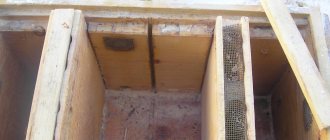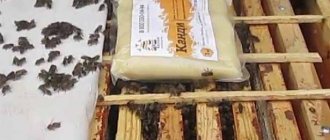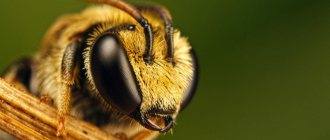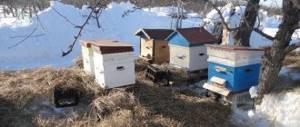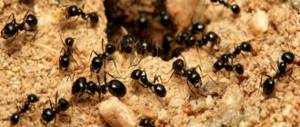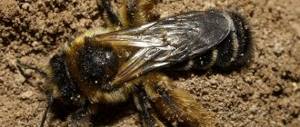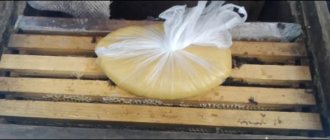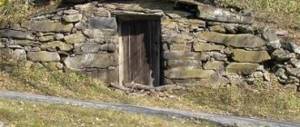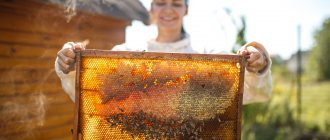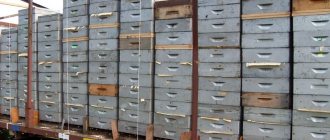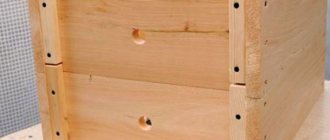General information about wintering bees
If you do not neglect the autumn check, the chances of maintaining worker bees in a hardy and healthy condition are higher. In September, possible risks are identified that can negate even the most thorough preparation. Several factors need to be taken into account:
- in order to count working young animals, it is necessary to evaluate the brood - it is on this segment that the survival of the population during cold weather will depend;
- the age of the queen bee determines the intensity of the colony increase, the speed and quality of seeding;
- worker bees must be active and protected from diseases;
- food reserves depend on the ratio of beebread and honey; if there is little food, the family will weaken, some will die.
To timely assess all the subtleties, the beekeeper studies the condition of insects and hives, the latter must be suitable for wintering the bee population. All preparatory activities are carried out in good weather so as not to disrupt the established life rhythm of the population.
When do bees need feeding?
For a good wintering, food supplies are of primary importance. Most beekeepers try to provide bee colonies with food supplies in the autumn. However, weather conditions are not always stable, and closer to February, families begin to become more active as brood appears. Therefore, there is a high probability that bees may need to be fed in winter - some experienced beekeepers even consider this a prerequisite for their successful survival.
Winter feeding may be necessary if there was not enough food in the fall (for an average family - about 1 kg per month) or if they contained low-quality food (honeydew, crystallizing honey).
Important! If, on the contrary, there is too much food, early scarring of the queen may occur, which is no longer desirable, since it may lead to very early flight and death of the bees.
There are several possible options for winter feeding of bees used in mid-latitudes.
Kandy for feeding
Kandi is a sugar and honey cake made according to a specific recipe. Feeding bees in the Kandy winter has several advantages:
- the dough has a thick consistency, so it can be easily placed on top of the frames;
- this type of food does not excite the bees, encouraging them to fly, but at the same time has sufficient energy value;
- If you place it in a plastic bag with holes made, the cakes can be stored and not dry out for quite a long time.
Sugar dough is prepared as follows:
- heat honey (sometimes invert sugar) to t+55°C so that there are no lumps left;
- cool the prepared product to +40°C and begin to add powdered sugar - as much as the liquid mass absorbs;
- in the final form, the dough should not be liquid or hard, it should be easy to handle and keep its shape;
- approximate proportions: honey (or sugar) – 26-29.8%!, (MISSING) powdered sugar – 70-74%!, (MISSING) water – 0.18%!, (MISSING) vinegar – 0.02%!
Flour, milk powder, etc. can be used as additives. Ready-made kandi, 1 kg each, is immediately placed in bags, and before feeding, 3-4 mm holes are made in them.
Life cycle of worker bees and their purpose
Sugar syrup for feeding
One of the most favorite ways for beekeepers to support families closer to spring. Feeding bees in winter with syrup has its own advantages:
- is a food with the absence of pathogenic microbes, which allows you to obtain the maximum amount of spring brood, which will provide the family with food during the difficult spring period;
- allows you to reduce the amount of death, since it does not overload the intestinal system of bees, and intestinal disorders when using it are minimal.
Important! However, sugar syrup alone in the absence of honey can cause protein starvation, which is unacceptable during the brood rearing period. Therefore, the types of feed should be alternated.
To prepare the syrup:
- pour the specified volume of water into a clean container and bring to a boil;
- stirring constantly, add sugar in small portions;
- make sure that the sugar dissolves and does not burn;
- when the solution begins to boil, remove from heat and allow to cool, covering with a lid.
The syrup is prepared in various proportions: from 40%! to (MISSING) about 70%! (MISSING) For example, to prepare 50%!s(MISSING) syrup, sugar and water are taken in equal quantities: from 1 kg of sugar and 1 liter of water, 1.6 liters of syrup are obtained. If a 70% solution is needed, the ratio of sugar and water is 2:1.
The finished syrup is poured into empty honeycombs and placed closer to the club. This is approximately 1.5-2 kg of food - for a strong family, a supply for a month. The second method is to pour the syrup into a jar, cover it with canvas, tie it tightly and place it upside down on a frame over the middle of the club. Two 0.5 liter cans are enough for a family.
Closer to spring, syrup is not recommended for feeding, as it encourages bees to behave actively and can provoke early flight. In addition, it cools quickly and remains unused.
Honey for feeding
The best option is to feed bees with honey in winter. This is natural food for insects, which contains all the substances necessary for reproduction, development and life.
Such feed is stored from the first harvest, when the honey is flowery and of high quality. In this case, the possibility of falling into the frame of honeydew or a variety that can crystallize is excluded. If there is no other food other than candied honey, it is heated artificially and fed to families.
Important! It is not recommended to store food from honey collected from rapeseed, white mustard, rapeseed, as well as from honey that was collected in dry weather. Such honey quickly crystallizes, and families begin to starve.
Specifics of increasing the strength and quality of bee colonies
The success of preparing bees for winter is directly dependent on the number of bees raised at the end of summer. Colonies in which young individuals predominate survive the cold months better and become stronger faster in the spring. Initially weak populations lose ground more during the winter and need more time next year to bounce back.
The more young bees, the higher the likelihood of a good winter.
The likelihood of a good winter is higher for colonies in which there are many young bees born from late August to September, and they are more actively involved in raising brood the following spring.
An important indicator when preparing for winter is the strength of the family. Bees spend effort to maintain a comfortable microclimate in the hive; the stronger the colony, the less its members wear out during the winter, the more optimally they spend food and energy. To strengthen families and reduce the number of dead animals, it is necessary to promptly replace old queens with young ones; the latter lay eggs faster at the end of summer; accordingly, more young individuals develop in their population by the onset of cold weather.
In order to stimulate the supporting bribe, thanks to which by autumn the queens lay eggs more intensively and raise brood, the bees are moved to late-flowering honey plants, such as heather and buckwheat. As a result, the bee family intensively educates the larvae, the potential of the group grows, and it winters better.
Preparing bees for winter. Basic moments.
Preparing bees for wintering should begin during the summer, and properly, since their development and productivity in the coming summer will depend on the results of how your bees overwinter. Preparing bees for wintering must necessarily include the following activities:
- ? preparing bee colonies at the end of summer, increasing the number of young bees, focusing the main effort on their hatching in August-September;
- ? change of queens, who work for two or more years;
- ? supplying bees with good quality food in sufficient quantities for the winter-spring period (25 kg) in honeycombs;
- ? and of course the creation of optimal conditions for the wintering of bees regarding normal temperature conditions and the necessary humidity in the winter.
So where do we start? The first thing that needs to be done in order to prepare bees for winter is a thorough inspection of bee colonies. In the process of this, you need to find out what condition the bee colonies are in after the end of the honey collection, which requires an inspection of all families immediately after you have removed the extensions and second bodies. All this must be done with a small bribe (0.2-0.4 kg each), immediately eliminating the identified shortcomings and starting to create conditions for the active growth of young bees for the winter period. If we take into account the middle zone of our country, then this moment occurs approximately in the first ten days of August.
What should you pay attention to first when examining families? First of all, you need to make sure that there is a queen, since after a belated swarming, or a change of queens and honey selection, it happens that in some families there are no fertile queens. In a situation where, when examining a bee colony, you do not see open brood, it is necessary to place a control frame with eggs and young larvae from another colony. After two days, examine the family again and if you find queen cells on the added frame, then your guesses about the absence of a queen have been confirmed. In this case, the family must be corrected in the same way as in the spring. And in those families where they have not yet replaced those queens who have worked for 2 years or more, it is necessary to give young queens from the cores, but do not forget that in the fall they lay much more eggs and the end of their oviposition occurs about 10 days later.
In the process of preparing bees for winter, we must not forget about taking into account the amount of brood (in terms of a full frame) and food reserves in each hive. After the main bribe, each bee colony should have at least 4-5 full frames. Those colonies that have less brood need to be supplemented by other colonies. When adding frames, do not forget that the nest must consist of full-fledged new combs in which bees were bred this year. And honeycombs with irregular cells: these are drone honeycombs, old, dark honeycombs, as well as light-colored honeycombs, but in which bees have not yet hatched, must be removed from the nest before wintering and replaced with good-quality ones. It happens that in those combs that are subject to culling, there is still brood, in this case such frames can be moved to the very edge of the nest, placing them next to the food ones, and after the bees are removed from them, the bees can be removed from the hive. At the same time, in the process of preparing the bees for wintering, the availability of food reserves in the nest is determined. As a rule, before wintering there is too little honey in the hive, but bees should not be left without food during the winter; the beekeeper has to replenish food reserves. Before the bees start for the winter, the presence of printed honey is taken into account, but open honey is not necessary to be taken into account, since almost all of it will be spent by the bees on growing the existing brood. Those frames that are without brood, but with a small amount of honey, must also be selected from the nest and saved for later use in the spring - to expand the nests. And finally, the honey left for the bees in the winter is determined for the presence of honeydew in it. Honeydew honey is unacceptable in winter food; if it is detected, such honey must be replaced with flower or sugar syrup. I have already described how to feed bees for the winter and form nests in previous articles.
Preparing bees for wintering must necessarily include an assessment of the strength of the bee colony, since this is one of the most important conditions for a good wintering of bees. If the inspection is carried out in the post-harvest period, then you can usually see quite a lot of bees in the colonies, but these are mainly those bees that worked intensively in the honey collection. And as experiments show, these bees die off quite quickly, and there are practically no more of them left for the winter.
In those areas where there is no supporting bribe after the main honey collection, the queens sharply reduce egg laying. As a result of this phenomenon, the composition of the bee colony is not renewed, which is why the colonies quickly weaken, and therefore do not winter well, and in the spring the colony is delayed in its development, as a result of which it does not have time to build up sufficient strength by the beginning of the bribe and therefore does not bring income to the beekeeper. Therefore, preparing bees for winter involves taking measures to increase the laying of eggs by queen bees, while calculating that the young bees that hatched last have time to fly around before the onset of cold weather. As for the middle zone of our country, bees should not be bred here after September 25, because in October there is not always favorable weather for young bees to fly around. And bees that have not completed their first cleansing flight become agitated in winter and disturb all the other bees in the hive, thereby disrupting the normal wintering of the colony, and, as a rule, about 30% of them die during wintering.
So how to properly prepare bees for winter by increasing the strength of families? The growth of young bees in winter is more successful if there is at least a small bribe from those plants that are still blooming in early August, so some beekeepers transport their apiaries closer to such honey plants. This method helps preserve food supplies and helps effectively increase the number of young bees for the winter. But if this is not possible, you can replace part of the feed reserves with sugar syrup. Moreover, this method of feeding has certain advantages over others. Firstly, queen bees occupy about 4-5 frames with brood, and secondly, bees on sugar syrup overwinter better, due to the fact that their intestines are less overloaded with undigested residues. In addition, when feeding, the bees themselves correctly place their honey in the frames, thereby creating a good, properly formed nest for themselves for the winter. Just don’t be late with feeding so that the bees have time to process all the food and seal it in time.
It is also possible to effectively increase the strength of families for the winter by forming temporary layers with queens and nuclei, in which the queens are raised to replace the main queens. These cores, which are left after the bees of temporary layers join the main colonies, usually have about 1 kg of bees by the time it is time to collect nests for the winter. Thanks to this addition of bees in the fall, the main colonies are able to significantly increase their strength and improve their quality composition.
In the process of preparing bees for winter, a lot of frames taken from hives accumulate in the apiary, these are both subject to culling, and good frames - both with honey and empty. They need to be sorted and stored separately in winter, because many of them may still be needed in the process of final assembly of bee nests for the winter. From the same frames that are subject to culling, but have a honey reserve, it is already possible to finally select and pump honey out of them.
The final assembly of the nest for the winter is usually carried out at the end of August or beginning of September - depending on the area where the apiary is located. All frames unsuitable for wintering, which for some reason were not removed during the first inspection, are removed, and benign frames prepared during the main harvest are given, which are at least half occupied with honey. The frame with beebread should be placed second from the edge of the nest, placing it between frames with 2.5 kg of honey. When preparing bees for winter, not all winter-spring food reserves are left in the hive. For each street with bees they give 2.0-2.5 kg of high-quality honey. The rest of the food should be stored in the form of sealed combs in your warehouse for the spring build-up of bees' strength. Frames with brood, but containing less than 2.0 kg of honey, are placed on the edge of the nest, after which they must be marked and removed from the hive after the bees leave.
When the nest has already been assembled for the winter, it must be carefully insulated from above and from the sides. The entrances in the hives must be reduced, leaving them open by 3-4 cm, and entrance barriers must be installed to protect against mice attacks. In order to better prepare bees for wintering, it is recommended to form upper entrances in the hives.
When the bees have finally made their last good flights, in the middle zone this happens somewhere in the second half of October, and stable frosty weather has arrived in early November, it is already possible to remove the hives with bees to winter huts and other adapted premises. Overwintering of bees outside in single-walled hives without insulation does not go well, since the bees in them require more food and overwinter with an increased fecal load. Wintering in cold hives is also accompanied by a large amount of deadstock, increased dampness, and the quality of honey and honeycombs may deteriorate.
The formation of a bee club with the onset of cold weather begins in the fall. And the time of its formation depends on the strength of an individual family. If the family is strong, then it begins to form a club when the ambient temperature drops to +7 degrees C, and in weak families this happens already at +13 degrees C. As the temperature decreases, the bees begin to leave the outer combs and move to warmer ones streets where the last brood hatches. In these streets, bees gradually become denser, forming a kind of crust along the edges, consisting of bees pressed tightly against each other. While wintering in the club, the bees consume very little food until the end of February (about 600-750g per month), this is the case if the ambient temperature ranges from 0 to +4 degrees C and nothing bothers the bees. But already from the end of February - beginning of March, many bee colonies begin to produce brood and feed consumption increases to 1.5 kg per month. Bees of strong families spend less energy to maintain the required temperature in the club, and therefore consume less food. Thanks to this, the fecal load of bees during the wintering period in strong colonies is less, which also contributes to a quieter wintering and less death. And, naturally, in the spring such families quickly begin to develop.
Preparing bees for wintering in different regions has some of its own characteristics. For example, preparing bees for winter in the southern regions, as a rule, does not involve the use of special premises for wintering bees. The hives are left in their places, only providing them with protection from the wind, and the entire wintering takes place in the wild. And in the central and northern regions, the apiary is usually moved to cold buildings, where the temperature is ensured close to the ambient temperature. When bees are preparing for wintering in underground spaces, cellars, cellars, where the constant temperature is from 0 to -4 degrees C, then it is possible to ensure a good wintering in them. As a rule, in the underground of a residential building, the temperature quite often rises above +4 degrees C, and in these conditions, only a clean canvas should be left on the frames and on top of it a straw or reed mat no more than 3 cm thick. In such wintering conditions, hives should have entrances open, but must be protected from mice. The roofs are removed from the hives, and a mouse net is placed on the roof cover.
If already during winter the temperature in dry rooms rises and the bees' anxiety increases, they should be given water in bottles that are suspended from the upper entrance. One end of the wick or gauze should be dipped into a bottle of water, and the second should be placed in the upper notch.
You can successfully winter bees in the wild. In order to prepare bees for such wintering, the hives are placed on
prepared stands that are filled with dry leaves, shavings, sawdust, or tow. For additional insulation on the outside of the hives, a frame is formed from planks in such a way that a space of about 15 cm is formed between the walls of the hives and the frame, which is also filled with sawdust or shavings. Slots are made in the front wall of the constructed frame, opposite the tapholes. And corridors 1 cm high and 10 cm wide are attached to the hive and through the formed slots in the frame they are brought out to ensure ventilation and flight around the bees.
The top of the hives must be covered with roofing felt to prevent moisture and snow from entering. With the onset of spring, when warm weather has already set in, the hives are unpacked. Instead of a frame (casing), the outside of the hives can also be packed with roofing felt; for this, insulation is placed under the bottom and around the walls. After this, the hives must be covered with snow. With the onset of spring melting, snow is carefully removed from the hives, and the entrances are cleared of dead bees.
And now a small summary of the above.
Preparing bees for wintering - the main stages.
- Qualitative examination of bee colonies with determination of the presence of a queen, the amount of brood and food supplies;
- Removing frames with poor-quality honeycombs from nests;
- Feeding bees and building colony strength;
- Formation of bee nests for the winter;
- Moving hives to winter huts or insulating them when wintering in the wild.
Don’t forget: a successful winter is a great start to the next season. Have an easy winter!)
Insect placement options
Depending on climatic conditions and the tasks facing the beekeeper, it is practiced to keep livestock in the wild, in omshanik, beds and multi-hulled hives.
In the wild
The feasibility of the method is determined by the fact that in regions with persistent frosts and heavy snowfall, it is easier for insects to survive in natural conditions. Due to the low thermal conductivity of snow, the temperature under its cover remains zero. In this case, the first flyby should occur early. In a pair of buildings, the upper and lower entrances should be uncovered, the first feed ones, in which the main group of bees gathers, the lower ones are air cushions. This method of keeping is accompanied by a small percentage of bees flying out and dying; usually only sick insects leave the hive.
In multi-hull hives
The solution is popular among large honey producers; even medium-strong and weak bee families overwinter well in properly prepared multi-hull hives. Unlike the frame method, here the population is characterized by high productivity; a simple feeding scheme is practiced. Multi-body structures house compact frames, so you can store less honey for the winter. Here it is necessary to provide for the possibility of moving individuals to free frames.
In omshanik
In such conditions, the population endures a harsh, windy winter without significant losses; the feeding method is similar to the previous option. Minimal consumption of honey prevents overload of the insect intestines, thereby eliminating the risk of disease. There is no phenomenon of rotting of the hulls; it is only important that the groundwater lies as far away as possible.
Wintering of bees in omshanik
In sunbeds
The method attracts with its simplicity and the ability to perform all actions alone. At the end of summer, the bees are moved to late honey plants, fed, and the condition of the colonies is checked. To reduce the excessive width of the hives, the beekeeper moves the frames from the entrance, creating a space in which the air will be warmed, which is important from the point of view of ensuring a comfortable microclimate.
Nest formation methods
Preparing bees for winter begins with the formation of a nest, and it needs to start on warm days, when the bees have not yet begun to swirl. In this case, it is necessary to take into account the behavior, strength and characteristics of the family, the nature of their movement around the hive.
Methods for creating a nest
Experienced beekeepers use 3 options:
- with the one-sided method, first a frame with 3 kg of honey is installed, followed by a container with 1.5 kg, then 3 frames are introduced, each containing 2 kg plus one frame with 2.5 kg. The design is completed by a pair of frames containing 3 kg of honey each;
- with the double-sided method, they start with two frames, each containing 2 kg of honey. Next comes a pair of frames with 2.5 kg, frames with 3-4 kg each are placed on the edge. In general, at least 20-22 kg of honey is laid;
- the most economical way is the “beard”, when frames with a small amount of honey are placed in the center.
In the third case, structures are placed radially with a gradual decrease in feed volumes. Under such conditions, the total consumption varies between 10-15 kg. The bars are installed perpendicularly and serve as guides. The technique is typical for weak families and is not widespread.
Ensuring adequate ventilation
The air exchange in the hive depends on the quality of ventilation: if there are no ways for carbon dioxide to escape and fresh air to come in instead, steam accumulates in the structure. As a result, the food spoils, the walls of the hive begin to rot, and the insects die.
The first measure is always to empty the entrances from below and above, but it must be taken into account that the bees fill the upper holes with propolis, thereby blocking the access to fresh air. It is also necessary to prevent the occurrence of noticeable drafts, they are detrimental to the population.
Balanced air exchange is ensured by the following measures:
- If the upper taphole is clogged with propolis, it is necessary to form compact holes in it or slightly move the boards apart. The steam produced by insects moves into this zone; it is necessary to prevent its accumulation and increased humidity;
- in severe frost conditions, holes and tapholes may freeze; it is important to inspect them in a timely manner and remove ice.
To prevent drafts from occurring, do not open the tapholes completely; an adjustable valve is useful here.
Insulation measures
The significance of this work is determined by the fact that reducing heat loss leads to significant savings in feed. Holes and cracks in hives should be excluded; they should be placed in areas protected from winds. When insulating internally, it is necessary to ensure high-quality ventilation so that disruption of air exchange does not cause fermentation of honey. Fiberboard, polyethylene, polystyrene foam, and fiber insulation can be used.
What are the stated deadlines?
Beekeepers recommend starting to inspect hives by the end of August, by which time the main honey supply ends. If you delay the initial preparation of the bees' nest for winter until the second half of September, there is a high risk of problems with the brood due to bad weather and the settling of individuals in the hive. The only exception is the expected dry, warm autumn.
Beekeepers' Tips
We recommend reading our other articles
- Zucchini variety Gribovsky 37
- The best self-fertile cherry varieties
- Tomato variety Velmozha
- Cement-sand coating for pipes: corrosion protection, increased service life, preservation of fluid quality
The recommendations listed below will help you avoid making serious mistakes when preparing bees for winter.
- Hive inspections do not always occur at the end of August. For the most part, preparation for wintering for the beekeeper begins from the moment the main harvest ends.
- In the fall, due to non-flying weather, bees can settle in the hive and sharply reduce the brood or stop it altogether.
The problem is that if the queen stops working in the fall, then this is for the whole winter and only in the spring will she begin to give birth again. To prevent the queen from stopping work prematurely, it is necessary to stimulate the bees with autumn feeding. Hive inspections do not always occur at the end of August - Sometimes beekeepers add vinegar to the syrup crust to increase its acidity. It is believed to be beneficial for bees. Approximately a teaspoon of vinegar is taken per liter of syrup. However, if you add more vinegar than normal, the bees will simply underinvent this syrup and will not seal it, due to the fact that the sugar will not be processed and it will remain in its pure form and will sour in the hive all winter. In order not to make a mistake, but still create an acidic environment, instead of vinegar, honey is added to the syrup (a fifth of the amount of syrup).
- If the autumn is very hot, you need to specially arrange bad weather conditions for the bees - open the hive slightly, create a draft, shade, so that they do not begin to replace themselves, as in the spring (this often happens). Otherwise, they will go into the winter unprepared.
Preparation and feeding options
Crystallizing honey is harmful to bees; here the priority is light flower products obtained from the main honey. This honey contains a minimum of honeydew components. Winter food cannot be supplied without studying the number of honeydew; in addition to contacting the laboratory, this can be done independently. If honeydew is found, the honey must be destroyed.
In addition to natural honey, sugar syrup, a mixture with potato juice, honey-sugar dough, and bee bread can be used. The first option does not contain vitamins and beneficial elements, but helps to warm the hive and maintain vitality. In an enamel bowl, boil 2 liters of water for 5 minutes, remove from heat, add 3.5-4 kg of sugar, stir until it is completely dissolved, and cool. If desired, you can add 1.2-1.3 ml of vinegar essence. The syrup is given warm in the evening, 5 liters per hive.
To get the potato mixture, sugar syrup is first prepared. The potatoes are peeled, washed thoroughly, passed through a grater or meat grinder and the juice is squeezed out. The resulting liquid is added 60 ml for each liter of sugar syrup, so the latter is enriched with useful substances.
To prepare the feed dough, 4 kg of sugar is processed in a blender to form powder. Heat 1 kg of honey until liquid and mix with powder to form a dough, add 100 ml of water. Half of the mass is rolled out into a flat cake no more than 2 cm thick and placed on a frame.
A set of measures to prepare bee colonies for wintering
If a mistake is made in the process of preparing bee colonies for wintering, then mass mortality can be observed. To eliminate this problem, it is recommended to adhere to some basic rules during preparatory work:
- provide the necessary amount of feed stock. In order for the bee colony to survive the cold season without losses, not to be exposed to diseases and to begin flying around with sufficient strength and energy, it is necessary to provide about 25-30 kg of honey and beebread for each hive. In some cases, the use of sugar syrup is allowed;
- An integral process of preparing bee colonies for winter is meeting the deadlines for the growth of young insects. Measures must be taken to ensure that the queen of the hive stops laying eggs by the end of August;
- Only strong bee colonies must be sent into winter, otherwise they may die. As a rule, in this case, many beekeepers prefer to unite a weak colony with a stronger one;
- Before the onset of cold weather, the hives must be completely insulated, and a ventilation system must be organized. If you plan to leave insects outside, then the insulation layer should be at least 15 cm.
By following these rules, you can not be afraid of death and illness.
Attention! It is recommended to install special barriers on the entrances that will prevent rodents from entering the hive.
Preventive treatment of the nest
Populations are vulnerable to diseases, which can lead to the death of insects in winter. In this connection, an important stage in preparing the nest is its processing after hatching the last brood and creating a winter hive. The greatest danger is represented by varroatosis and nosematosis.
Complementary feeding is practiced using medicines - they are introduced into liquid sugar syrup, thereby the insects receive help along with food. The selection of the current drug should be done by a veterinarian; usually, for varroatosis, Apimax is prescribed, for nosematosis, Fumagilin.
Apimax is used for feeding bees
The hive is filled with smoke using a special cannon, then the structure is closed for 20 minutes; it is advisable to carry out this procedure twice. Using a gun, you can also treat the nest with special preparations intended for thermal use, for example, Phenothiazine, Folbex, Bipin.
Liquid products are applied to a plate suspended in the hive, insects touch it and distribute the drug over the entire internal area, increasing the area of influence. The plate can also produce vapors that will affect individuals through the respiratory tract. Oxalic acid and Nosemaline are relevant here.
The nuances of wintering outside
To help bees survive the cold months better, you should help them:
- organize feed delivery and preventive treatments in a timely manner;
- increase the strength of families, as a last resort, unite several weak families in the hive;
- introduce new queens to replace the old ones;
- minimize external stimuli that can have a negative impact on the population.
The houses must be intact, protected from pests and rodents with the help of special grilles mounted under the lid and on the entrance. If insulation is carried out with snow, you need to make sure that it does not come into contact with the walls - in sunny weather it will melt and dampness will penetrate into the nest.
